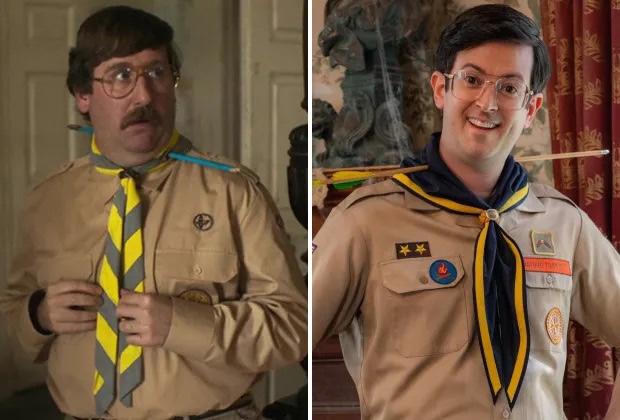
This flaw in regards to Pete, or rather refusal to acknowledge flaws in Pete while he’s being the hand puppet for the writers, is particularly annoying because as I’ve said before there is potential in Pete. He is the sort of character that could have been interesting – or more importantly for a comedy show, funny – if you took the time to peel away the lairs of chipper niceness and really examine him as a person. At least for a second. And I know this fact because I’ve seen it in his British counterpart.
Pat and Pete are unique amongst the ghosts in quite how similar they are. While many of the ghosts have counterparts from different eras and cultures – such as Thor (Viking) and Robin (Caveman) both the oldest ghosts in their respective shows with power over electricity – and sometimes noticeable different personalities – such as the quite theatrical Isaac (American Revolutionary General) and the more reserved Captain (WWII British Captain), both gay men who were forced to stay in the closet during life due the restrictions of their respective time periods; Pete is an almost direct translation of Pat to an American audience.
Both men are upbeat chipper scout masters who died in the 80s through an arrow to the neck. They both discovered their wives had had an affair with their best friend, while they had been alive. And they both have grandsons who are named for them. This only makes the one greatest difference between them all the more noticeable , and no it’s not that one is allowed to have flaws and the other isn’t, it’s that only one of them is allowed to acknowledge those flaws as flaws and actually grow from them. While the other is relentlessly coddled both by the writers and the other characters.
For instance, let’s take a look at two parallel storylines for these nearly identical men. They are confronted with a reminder of their death, and are forced to come to the realisation that they had a part to play in said death. But are comforted somewhat when a former scout of theirs clearly still remembers the lessons they taught them. With Pete this is done in the episode “Dumb Deaths” when said show wants to make an episode around his rather embarrassing death. A huge amount of effort is gone to by the other characters , to prove he didn’t have a dumb death including summoning one of the old scouts who witnessed it . This does not work, as standing in front of children who you have just armed before you gave them the safety lecture is a very dumb way to die. However when someone gets shot in the ass, the former scout is able to hop into action due to the lessons Pete taught her. And thus, Pete is comforted when the other characters explain this to him.
Pat’s story arch is somewhat different. For instance the former scout is not summoned to the house to make Pat feel better about his own stupidity , he’s there to attend a wedding and oh did I mention, he’s also the one that shot Pat through the neck. Thus this story is more about Pat overcoming his own rage at the person that’s technically his murderer than it is making him feel better about something dumb he did. After seeing how deeply affected the now full grown man is about the accident, Pat is able to finally forgive him and let go of his rage. Admitting that it probably was at least partly his own fault, he should never have handed the bows out so soon. No one is made to be the villain, it’s a very human story about very human feelings – despite being about ghosts. But you know what that story is above all else, interesting to watch.
Notice that it’s not that both characters didn’t do something dumb that got them killed, but rather where the focus of the narrative is. While Pat is allowed to acknowledge his own failings in a moment of quiet realisation after finally forgiving the scout that shot the arrow , Pete’s reaction when his own stupidity is pointed out to him is so over the top that the focus of the story must then become comforting and placating him. We must stop the show from airing, and when that fails we must again point out to Pete that the adult scout knows what to do when someone is shot with an arrow because of what Pete taught her. While we do see a similar thing in the British show, it comes off more as Pat’s pride in the adult scout, rather than just his own skills as a teacher.
Because Pete must never be truly wrong in a lasting way, he is denied that self-reflection that made Pat’s story so moving. And I can’t help but find it ironic that considering the implied purpose of the Adaptation’s plot, is to help the ghosts grow as people and eventually be ‘sucked off’ – they would kneecap one of their characters in such a way. After all, if Pete’s soul is as Elias notes in one Season 2 Episode ‘as pure as snow’ – why is he still here? And if the answer turns out to be ‘to help the others’ then I am leaving now.
If you’ve enjoyed this post, and would like to see others like it as soon as they come out, remember to follow the Wee Blog if you haven’t already. And hop on over to X, Instagram, Mastodon, Threads, Pinterest, Tumblr, TikTok, Youtube, Goodreads, Kofi , Spotify, and Facebook where I am also active. Also sign up to the Wee Mailing List so you don’t miss the final conclusion to this ghoulish blog series. Until next time Wee Readers, stay safe and happy, and have a very bonnie day.